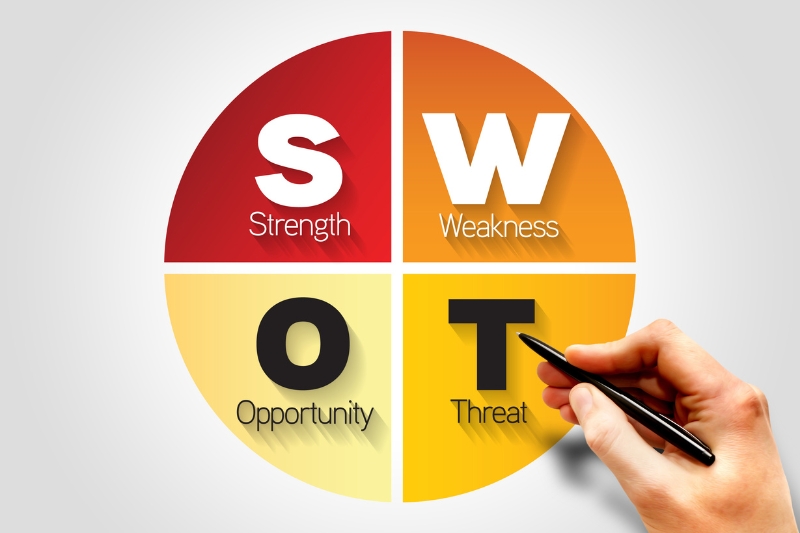Let’s face it, the fitness market is competitive. Whether you’re running a cozy neighborhood gym or a large fitness chain, plotting your path to growth is essential.
A key tool in your strategic planning toolkit?
It’s your compass in this fitness landscape, helping you identify your gym’s strengths, weaknesses, opportunities, and threats.
It considers both internal and external factors that can influence your business’ performance.
In this article we dig deep into the world of gym SWOT analysis, showcasing its importance, and how to use it effectively.
Understanding SWOT Analysis of a Gym Business
Before we get to apply SWOT analysis to your business let’s understand what SWOT analysis is all about and how it plays out in the world of fitness.
Understanding Strengths

Strengths represent the assets and advantages that give a gym a competitive edge over other fitness centers. They are internal to the business and thus, can be controlled and improved upon.
Specialized Equipment: Having the latest, high-quality, and diverse range of workout machines and equipment can be a significant strength. This not only attracts a wider demographic of gym-goers but also promotes effective and efficient workouts.
Experienced Personal Trainers: Offering skilled personal trainers can be a vital strength. It gives members access to professional guidance, ensuring they follow correct workout protocols, which helps reduce the risk of injury and increases the effectiveness of workouts.
Unique Fitness Classes: Offering a variety of fitness classes from Zumba to spinning, yoga, HIIT, and pilates not only cater to a broad audience but also break the monotony of regular workouts.
Strong Brand Reputation: Building a robust brand reputation through quality fitness services, customer satisfaction, and positive word of mouth is a crucial strength. It helps in attracting and retaining members. A strong brand reputation starts with a compelling name. To learn more about creating a name that reflects your gym’s unique strengths and brand, check out our guide on How to Choose a Gym Name.
Addressing Weaknesses

Weaknesses are the areas where the gym may lack or have inferior offerings compared to competitors. Recognizing and addressing these areas is vital for maintaining competitiveness.
Outdated Equipment: Outdated or poorly maintained equipment can hamper the overall customer experience, lead to injuries, and drive away members.
High Membership Costs: While quality services demand a premium price, excessively high costs compared to other gyms offering similar services can be a deterrent for many potential customers.
Poor Customer Service: Customer service plays a significant role in any service-based industry. Inadequate service can lead to member dissatisfaction and harm the gym’s reputation.
Lack of Digital Presence: In an increasingly digital world, not having an engaging online presence or a user-friendly gym management software for scheduling sessions and providing information can be a weakness.
Exploring Opportunities

Opportunities are external factors that the gym business can exploit for growth and improvement.
Health and Wellness Trend: With the rising trend of health consciousness, gyms have the opportunity to attract more members, introduce new wellness programs, and become a one-stop shop for fitness and health needs.
Digital Fitness Programs: The surge in online training programs offers gyms an opportunity to reach a larger audience, offer personalized training programs, and generate additional revenue.
Partnerships: Collaborations with corporate wellness programs, local businesses, or health food restaurants can create mutually beneficial opportunities.
Mitigating Threats

Threats are potential external factors that could harm the gym’s business. Identifying these in advance helps develop strategies to counter them.
Rising Competition: The fitness industry is highly competitive. New entrants, especially those offering lower prices or more innovative services, can pose a threat.
At-home Fitness Trend: The growth of at-home fitness options, especially during the COVID-19 pandemic, poses a significant threat to traditional gyms.
Economic Fluctuations: Economic downturns and periods of financial uncertainty can lead to reduced memberships as people cut back on non-essential spending.
Regulatory Changes: Changes in health and safety regulations can impact operations and necessitate unexpected expenditures to ensure compliance.
A gym’s SWOT analysis should be an ongoing process, given the dynamic nature of the fitness industry. It allows the business to stay ahead of the curve, continually improve its services, and maintain a robust strategic plan for long-term success.
How to Apply SWOT Analysis For Your Gym Business?
SWOT analysis, while insightful, is only as valuable as the strategic planning derived from it. Here’s how a gym business can use a SWOT analysis to create a robust, proactive strategy.
Capitalize on Strengths
The key to leveraging strengths lies in understanding what sets your gym apart from competitors and making the most of these aspects.
Enhancing Unique Offerings: If your gym has unique fitness classes, consider promoting these heavily, offering more time slots, or even developing new unique classes based on member feedback.
Upgrading Equipment: If your strength lies in your state-of-the-art equipment, regular upgrades and maintenance should be prioritized to keep this competitive edge.
Building on Brand Reputation: If your gym has a strong brand reputation, leverage this through marketing campaigns, partnerships, and member referral programs.
Address Weaknesses
Addressing weaknesses involves acknowledging areas where improvement is needed and taking necessary steps.
Revamping Equipment: If outdated equipment is a weakness, plan, and budget for regular upgrades and maintenance to enhance the overall workout experience.
Reassessing Pricing Strategies: If the cost of gym memberships is high, consider reassessing your pricing strategy or offering added value to justify the price, such as free personal training sessions or nutritional advice.
Improving Customer Service: If customer service is lacking, invest in training for your staff or consider hiring a dedicated customer service team.
Enhancing Digital Presence: If a lack of online presence is a weakness, invest in improving your website, app, or social media presence.
Seize Opportunities
Opportunities can be capitalized on through strategic planning and proactive steps.
Embracing Health Trends: With people becoming ever more health conscious, gyms can introduce wellness programs, nutritional guidance, or mind-body classes to cater to this market.
Incorporating Online Programs: The trend toward digital fitness programs is an opportunity for gyms to expand their reach. Offering online personal training sessions can help attract members who prefer to work out from home.
Forming Strategic Partnerships: Partnerships with businesses or corporate wellness programs can help reach a broader audience and offer mutually beneficial services.
Mitigate Threats
Identifying threats helps gyms to develop proactive strategies to counter potential challenges.
Staying Competitive: To address rising competition, gyms need to continuously innovate, maintain high service standards and offer competitive pricing.
Addressing At-home Fitness Trend: To counter the threat of at-home fitness, gyms can offer hybrid models that combine in-gym and online classes, allowing members to workout from anywhere.
Managing Economic Fluctuations: Having a diversified income stream, such as offering online classes, selling fitness supplements, or providing nutritional guidance can help mitigate the effects of economic downturns.
Keeping Up with Regulations: Regularly reviewing and staying updated with health and safety regulations is essential to ensure compliance and avoid penalties.
The goal of strategic planning using SWOT analysis is to align the gym’s resources and capabilities to the competitive environment in which it operates. Regular review of the strategy is crucial to adjust to changing market dynamics and to keep the gym business robust and prepared for future growth.
Examples of SWOT Analysis in Leading Gym Businesses
Analyzing leading gym businesses via SWOT analysis provides useful insights for anyone venturing into the fitness industry. Here, we examine some of the popular gyms.
1. Planet Fitness Swot Analysis
- Strengths: Beginner-friendly, affordable memberships.
- Weaknesses: Lacks high-end equipment and personalized training services.
- Opportunities: Potential for corporate wellness partnerships.
- Threats: Rise of at-home fitness programs and boutique studios.
2. Gold’s Gym Swot Analysis
- Strengths: Premium fitness facilities, high-quality equipment, experienced trainers.
- Weaknesses: Poor financial management, and underestimation of competition.
- Opportunities: Expansion of personal training services.
- Threats: Competition from lower-cost gyms.
3. Anytime Fitness Swot Analysis
- Strengths: 24/7 availability, vast global network.
- Weaknesses: Limited specialized equipment or class offerings.
- Opportunities: Expansion in untapped markets, digital fitness technology.
- Threats: Competition from other 24-hour gyms and digital fitness platforms.
These examples show how understanding and applying SWOT analysis can significantly impact a gym’s strategy and success.
Conclusion
The dynamic fitness industry calls for a thorough understanding of one’s business position.
A Gym SWOT analysis provides that insight, giving a gym the knowledge it needs to play to its strengths, work on its weaknesses, seize its opportunities, and brace for potential threats.
Therefore, whether you’re a multinational fitness club or a local fitness center, conducting regular SWOT analyses could significantly enhance your business performance and preparedness.
For those looking to dive deeper into the world of gym ownership, our blog offers an Ultimate Guide on How to Open a Gym. It covers everything from strategic planning to market analysis, providing you with the essential knowledge needed to establish a thriving fitness facility.
FAQ
What is the SWOT analysis of a gym business?
A SWOT analysis of a gym business identifies the internal strengths (e.g., experienced trainers, modern equipment, unique classes) and weaknesses (e.g., high prices, outdated equipment, limited service offerings), and external opportunities (e.g., growing health trends, technology advancements, potential partnerships) and threats (e.g., rising competition, changing regulations, economic downturn, increase in at-home workouts) in its operating environment.
What are some weaknesses in a gym?
Some weaknesses in a gym might include outdated equipment, high membership costs, poor customer service, limited fitness class offerings, and insufficient operating hours.
What is a SWOT analysis for a gym trainer?
A SWOT analysis for a gym trainer identifies their strengths (e.g., certification level, specialty expertise, client relationships), weaknesses (e.g., lack of experience, limited client base, restricted schedule), opportunities (e.g., increasing demand for personal training, online training options, niche fitness trends) and threats (e.g., competition from other trainers, clients’ financial constraints, changing industry standards).
What are 3 examples of strengths in SWOT analysis?
Three examples of strengths in a SWOT analysis could include a strong brand reputation, highly skilled personnel, and unique product or service offerings that distinguish the business from its competitors.




